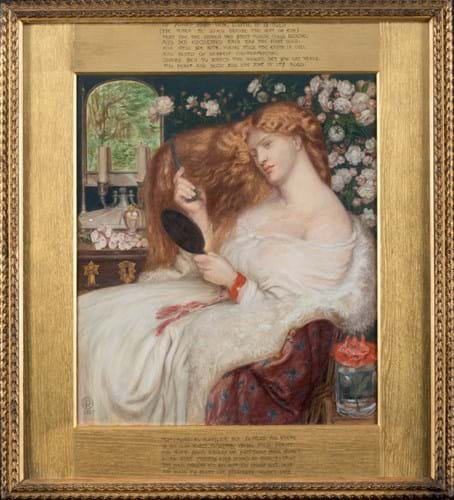
Believed to be the only version of this work by Rossetti in private hands, it comes to auction for the first time in 30 years with an estimate of £400,000-600,000.
Artist muse and lover Fanny Cornforth as Lady Lilith is an ode to Cornforth and her corn-gold hair.
The painting, which has has been in Japan for many years, will be offered at Sotheby’s London sale of Victorian, Pre-Raphaelite & British Impressionist Art on July 13.
The artwork was painted during Rossetti’s most innovative period in the 1860s, when he created the cult of the Pre-Raphaelite beauty, or ‘Stunner’ as he called them.
Sotheby’s said Rossetti’s decision to use Cornforth as Lilith was a deliberate decision because “Fanny was most likely the first woman that Rossetti slept with and Lilith was the first woman, created from the same earth as Adam before the creation of Eve”.
She was his mistress while Rossetti was married. After his wife Lizzie Siddal committed suicide in 1862, Cornforth moved into Rossetti’s studio to be his housekeeper.

Dante Gabriel Rossetti’s lover and muse Fanny Cornforth. She was admired for her hair and was one of the Pre-Raphaelite movements beauties, referred to as a ‘stunner’ by Rossetti.
Rossetti began the first version of Lady Lilith, which is now in the Delaware Art Museum, in 1864 as the first commission for Frederick Richards Leyland, who would become the artist’s greatest patron. Leyland disliked the way Rossetti had painted Lilith’s face and asked him re-paint it using the face of a professional model named Alexa Wilding.
Rossetti (1828-1882) had made two watercolour replicas of Lady Lilith before the repainting was undertaken, both of them in 1867, the year the oil was completed in its original form.
One of these, made for the collector William Coltart, hangs in the Metropolitan Museum of Art, New York, while the other, made for Alexander Stevenson, is the version to be offered for sale.
Cornforth was devastated when she learnt that her face had been changed and she did not pose for another painting by Rossetti, although she did eventually forgive him.
Cornforth and Rossetti remained close and he helped support her through financial difficulty.
But after his death she suffered from dementia and moved to Graylingwell Hospital, a Sussex county asylum where she died in 1909.





